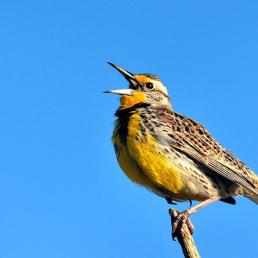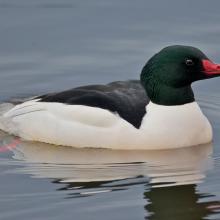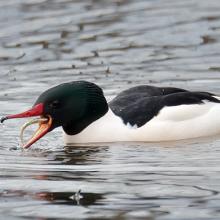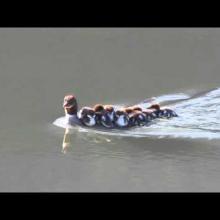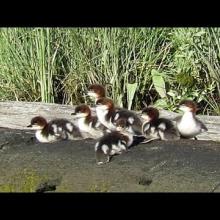

Join BirdNote tomorrow, November 30th!
Illustrator David Sibley and actor H. Jon Benjamin will face off in the bird illustration battle of the century during BirdNote's Year-end Celebration and Auction!
Poet Joyce Clement writes haiku, a traditional Japanese form. While it's often thought of as having three lines with 5-7-5 syllables, Joyce says that the key elements of any haiku are a fragment and a phrase spoken in a single breath. In this sequence of haiku, Joyce juxtaposes punctuation marks with images of birds, drawing on their similar appearances, as well as meaning.
BirdNote®
Joyce Clement: Birds Punctuate the Days
Written by Mark Bramhill
Mark Bramhill: This is BirdNote.
It's National Poetry Month in the US, and we're celebrating by sharing some bird-related work from contemporary poets. Joyce Clement writes haiku, a traditional Japanese form. Often thought of as having three lines with 5-7-5 syllables, many English haikus don't follow this pattern strictly. There are many common traits to haiku — they're often about nature, about a moment in time, reference a season — but all good rules are made to be broken. The essential part to Joyce:
Joyce Clement: It is a one breath poem that usually consists of two parts: a fragment and a phrase. And those two parts are juxtaposed next to each other and form a type of relationship.
Mark Bramhill: In this sequence of haiku, Joyce juxtaposes punctuation marks with images of birds, drawing on their similar appearances, as well as meaning and function. Listen for how these work together:
Birds Punctuate the Days
apostrophe
the nuthatch inserts itself
between feeder and pole
semicolon
two mallards drifting
one dunks for a snail
ellipses
a mourning dove
lifts off
asterisk
a red-eyed vireo catches
the crane fly midair
comma
a down feather
bobs between waves
exclamation point
wren on the railing
takes notice
colon
mergansers paddle toward
morning trout swirl
em dash
at dusk a wild goose
heading east
question mark
the length of silence
after a loon’s call
period
one blue egg all summer long
now gone
Mark Bramhill: In each haiku in the sequence, you can see the different kinds of relationships between bird and punctuation. Joyce was initially inspired by the down feather bobbing in the water — its shape like a comma, moving in arcs, with a repetitive, list-like quality to its motion. Or in the haiku about the loon…
Joyce Clement: It's all about asking questions. you've got a question mark and then that silence that it talks about creates a question, will there be a response? It fosters a sense of loneliness. Which, you know, the loon’s call often evokes, right?
Mark Bramhill: Or for the mergansers, it was inspired by her memories seeing them in the summer in the Adirondacks.
Joyce Clement: And you know, there was a merganser paddling along followed by, I don't know, you know, it seems like a hundred chicks, but you know, 10 chicks, all just in a row, as they do. It's quite amusing. But that's what made me think of the colon mark, because the colon indicates what to follow is going to be a list, right? So there was female merganser, followed by the list! Which was all these other, you know, little, uh, mergansers following along. So it had to be mergansers!
Mark Bramhill: You can keep celebrating Poetry Month with more wonderful writing at our website, BirdNote.org. I'm Mark Bramhill.
###
Senior Producer: John Kessler
Content Director: Allison Wilson
Producer: Mark Bramhill
Managing Producer: Conor Gearin
Bird sounds provided by The Macaulay Library of Natural Sounds at the Cornell Lab of Ornithology, Ithaca, New York. White-breasted Nuthatch ML 176168 recorded by G. Keller, Mourning Dove ML 125320641 recorded by J. McGowan, and Common Loon ML 381016291 recorded by D. MacNeal.
BirdNote’s theme was composed and played by Nancy Rumbel and John Kessler.
© 2022 BirdNote April 2022
Narrator: Mark Bramhill
ID# poetry-03-2022-04-29 poetry-03
